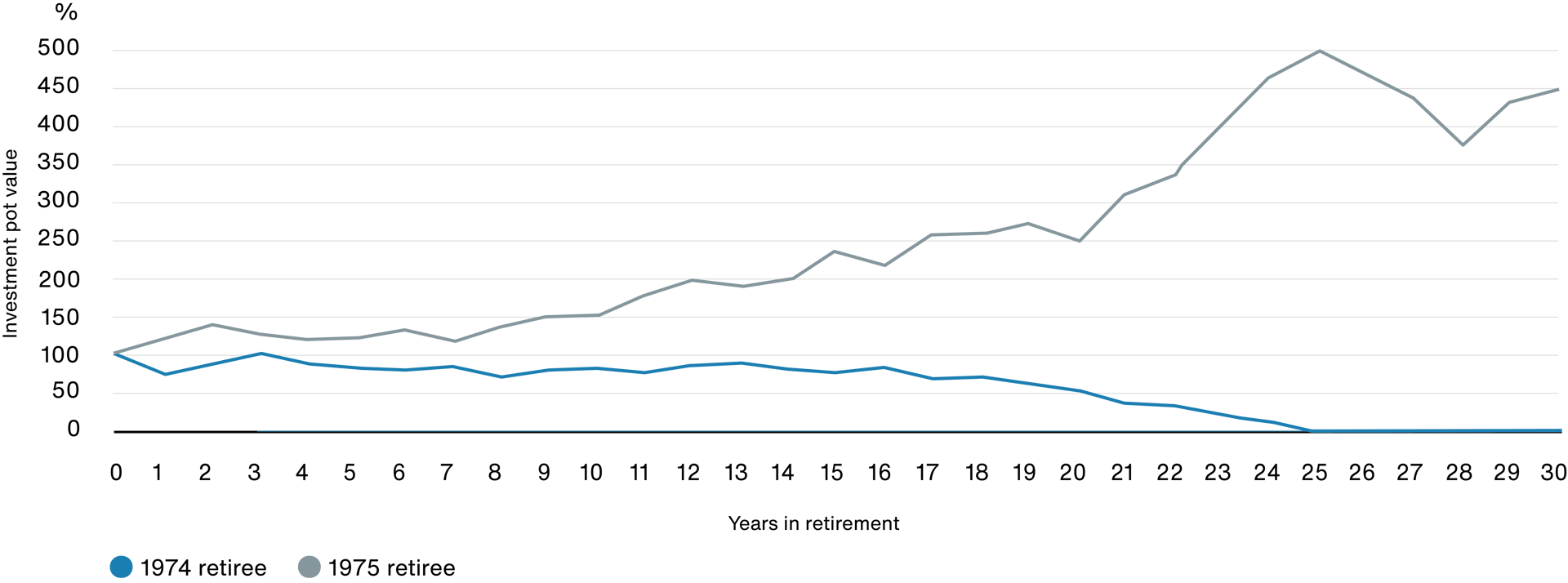
All investment strategies have the potential for profit and loss, your or your clients’ capital may be at risk and income is not guaranteed.
Today’s retirees need to set themselves up for the long term. Women reaching the state retirement age this year can expect to spend over 20 years in retirement, and one in four will add another decade to that. What does that mean for Generation DC? How can you draw the highest possible income today without jeopardising your long-term plans?
Upon entering retirement, there are two obvious options – buy an annuity or adjust your investment objective and stay invested.
With interest rates higher, today’s annuity rates look more attractive than at any point in recent years. Why consider taking an investment risk?
There are two reasons – inflation and flexibility. Higher annuity rates can appear attractive and these do, of course, have a place for some retirees. The income from a fixed annuity is guaranteed, while investment income cannot match that certainty. While it’s guaranteed, it is also fixed for the rest of a retiree’s life. Even if inflation rates are benign, its purchasing power is eroded over time.
Over the course of a multi-decade retirement, inflation can put a substantial dent in the purchasing power of a fixed income stream. While there are inflation-linked annuities available, the starting income is much lower so the ‘cost’ of protecting against inflation in the annuity market is high. And finally, either way, the decision to purchase an annuity takes away the flexibility to retain your capital and hopefully see it grow.
While annuities can provide immediate stability, we would argue that many investors should make their capital work harder, for longer. This approach can allow retirees to keep more options open in later life, with the potential to achieve a better overall outcome – considering capital and income together.
Investment risk: a risk worth taking?
£500,000 pension pot: three options

Source: Baillie Gifford & Co. Hargreaves Lansdown. Fixed annuity income quote generated on 23 November 2023 using Hargreaves Lansdown's online annuity quote tool, which compares the rates available from the UK's leading annuity providers. Assumptions: A 65-year-old non-smoker with a £500,000 pension pot. The income drawdown product assumes that both income and capital value will increase in line with inflation (2.9% a year) to 2040. All projected returns are net of fees.
We argue that harnessing the power of markets can deliver a better outcome. There are two traditional approaches to generating income – a total return portfolio with regular withdrawals or an income-orientated portfolio. Unfortunately, the total return approach comes with the substantial risk of timing your retirement. While it is generally true that timing your initial investment makes little difference over the long term, this is no longer true when regular withdrawals are made from the portfolio.
This means that the timing of returns really matters in retirement. Take an example of two retirees, one retiring in 1974 and the other in 1975. They both invest in a portfolio composed of 60 per cent equities and 40 per cent corporate bonds, decide to draw 5 per cent of their initial capital annually, and adjust the figure in line with inflation. The 1974 retiree was dealt a bad hand in the ‘retirement date lottery’ – high inflation resulted in multiple interest rate rises, and we saw a significant bear market in equities and bonds. The poor returns that year are exacerbated by withdrawals from the portfolio. Their 1975 retiree counterpart, by contrast, sees a prosperous retirement, leaving them with more options later in life.
This is clearly a fairly extreme example, but what can we take from it? Finding yourself in a position where you need to sell down capital at inopportune moments can have a lasting and unrecoverable impact on your pension over the long term.
The retirement date lottery
Sequencing risk in action – 60/40 portfolio with a 5% withdrawal adjusted for inflation

Source: Bloomberg. Data to end December 2023.
How do you avoid playing the retirement date lottery? We believe that the best way is to focus on generating a high level of ‘natural income’, income from dividends and coupons. This can allow you to limit, or completely avoid, withdrawals from capital. We therefore believe that income investing could offer a sustainable alternative. However, we think it is also important to avoid the lure of high current yields from companies nearing their ‘best before’ date, and instead focus on generating income that can grow over time.
Our Sustainable Income portfolio was set up to take on this challenge and to deliver what it says on the tin: a sustainable income stream. To us, this means an income that grows with inflation over time. We aim to produce that by investing globally across eight different asset classes, in companies and countries that we believe are adapting to the world’s challenges to be the best income payers of tomorrow.
We seek to deliver the highest possible level of resilient natural income, that can be relied on to meet financial goals and commitments for many years.
Income for the long haul
But how can the assets we invest in generate income that can be depended on for decades to come?
We believe focusing on long-term income growth is the answer. Investing in a variety of asset classes allows us to match their different characteristics so we can deliver a resilient income today and grow it over time. Thanks to increased interest rates fixed income offers more attractive income levels. Our global reach allows us to look beyond traditional fixed income asset classes, benefiting from higher yields on offer.
When it comes to stable, inflation-matching income growth, we look to real asset classes: infrastructure and property. Our infrastructure investments were very valuable last year, delivering diversification benefits at a time when both equities and fixed income struggled. The income resilience that is often coupled with contractual linkage to inflation is a great match for our objectives, so while we have taken some profit since last year, it remains a key part of our strategy.
Last but not least, the engine of real income growth is equities. That is, if you pick the right ones.
Long-term income, not short-term yield
Aiming to fully reap the benefits of our broad opportunity set, we invest in a bespoke portfolio of hand-picked investments within each asset class. We test them for resilience and their potential to be the best income payers of tomorrow.
When the objective is finding income that can last for decades, it’s crucial to think about an investment’s potential five or ten years from now. While that may sound obvious, fascination with yield leads many ‘income’ investors to focus on this year’s dividend and coupon payments. They often take on significant risks to both income and capital in the process.
The most recent evidence of this ‘yield first’ approach faltering came at the beginning of the pandemic, when we saw many of the UK’s largest dividend payers cut or cancel their dividend payments. Since then, many of those payments have either not returned or have resumed at a more modest level.
That’s why we focus on how a company’s dividend will progress over a longer period. Take the Danish pharmaceutical company Novo Nordisk, a holding since inception in August 2018. With a low current dividend yield, most income investors would give it a miss. However, since 2018 the company has grown its dividend by over 40 per cent and enjoyed significant capital growth – this is exactly the type of income investment we look out for. The trajectory of its dividend potential remains as exciting as ever, which is why it is still among our largest equity holdings.

Fit for the future
Sustainability has two meanings. Will an investment’s income stream prove to be sustainable over long periods of time? And is it sustainable from an ESG perspective? We believe the two are inextricably linked: the best income payers of tomorrow will be forward-thinking companies that are successfully adapting to meet the needs of a sustainable economy.
Can you build an income portfolio without the income investing classics such as oil and tobacco producers? We think you certainly can. Even more importantly, if you want a sustainable long-term income, we think that you should. In our view, increased regulatory scrutiny and transition costs make oil and tobacco unappealing investments, and we see better opportunities for income growth elsewhere.
Our sustainability assessment is centred on a core question: is this investment compatible with a sustainable economy? We analyse all individual investments held in the Sustainable Income portfolio, from equities to emerging market bonds, infrastructure companies to investment grade bonds. While each asset class has its nuances, we take one consistent approach whereby the ESG analyst brings together the bottom-up work of our teams.
Why we believe accepting investment risk makes sense
The need to create a sustainable retirement income stream becomes more urgent as Generation DC is entering decumulation. Income investing is about reducing inflation and sequencing risk, all the while retaining flexibility. We believe that our broad opportunity set, as well as the combination of skilful asset allocation and experience in stock picking, allows us to harness the best income payers of tomorrow to deliver real income, time after time.
Risk factors
The views expressed should not be considered as advice or a recommendation to buy, sell or hold a particular investment. They reflect opinion and should not be taken as statements of fact nor should any reliance be placed on them when making investment decisions.
This communication was produced and approved in January 2024 and has not been updated subsequently. It represents views held at the time of writing and may not reflect current thinking
Potential for profit and loss
All investment strategies have the potential for profit and loss, your or your clients’ capital may be at risk. Past performance is not a guide to future returns.
This communication contains information on investments which does not constitute independent research. Accordingly, it is not subject to the protections afforded to independent research, but is classified as advertising under Art 68 of the Financial Services Act (‘FinSA’) and Baillie Gifford and its staff may have dealt in the investments concerned.
All information is sourced from Baillie Gifford & Co and is current unless otherwise stated.
The images used in this communication are for illustrative purposes only.
Important information
Baillie Gifford & Co and Baillie Gifford & Co Limited are authorised and regulated by the Financial Conduct Authority (FCA). Baillie Gifford & Co Limited is an Authorised Corporate Director of OEICs.
Ref: 86100 10042714




